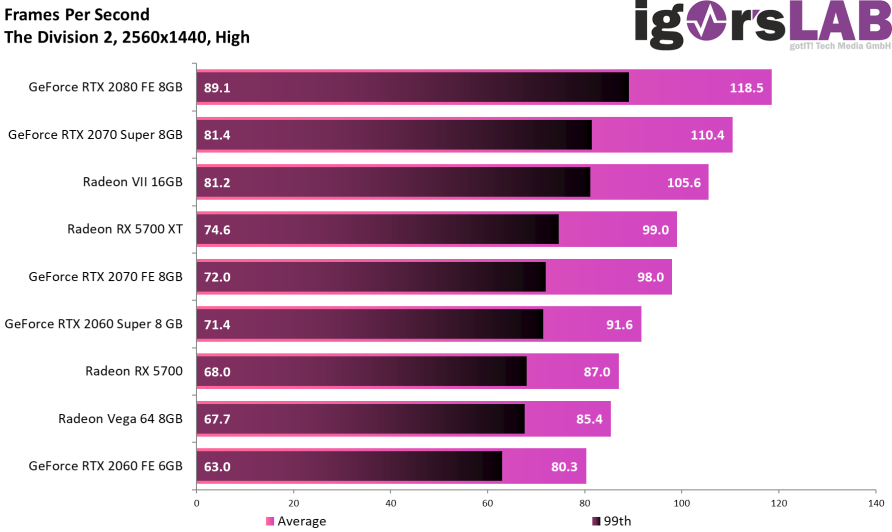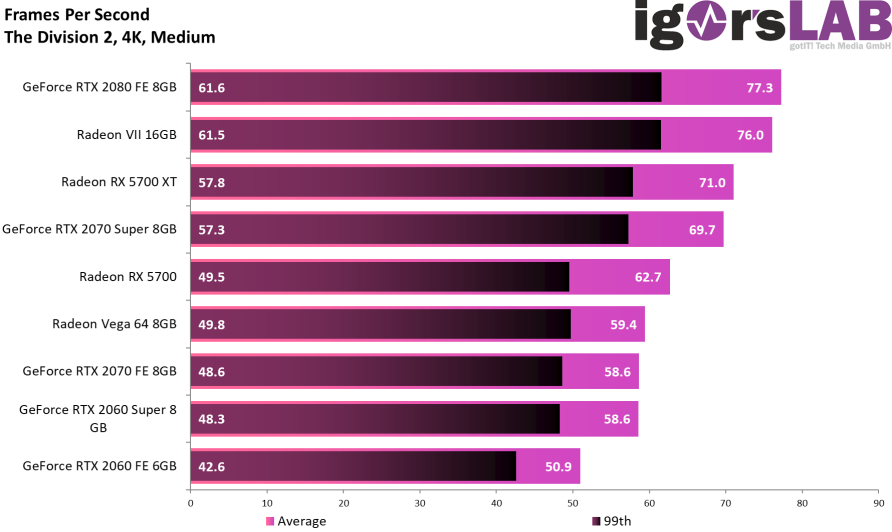For all benchmarks, I deliberately chose all three common screen resolutions and adapted the settings more to the usability. So this is not about "beautiful living", but about "fast playing". I'm sure the benefits are more likely and I've never understood why you want to see Full HD as a resolution only on the absolute entry-level cards. Otherwise, all graphics are self-explanatory anyway and I spare myself the novels of the verbal description of what you can already see with your eyes.
Benchmarks in Full HD with 1920 x 1080 pixels
I have deliberately chosen the highest settings for these benchmarks, as all maps here provide very useful frame rates.
The curves for the FPS gradient, the frametimes, and the percentiles provide further information about what beams cannot fully predict.

The Division 2 - AvFPSoB - 1920x1080, DX12, 4x MSAA Crazy

The Division 2 - FPS99th - 1920x1080, DX12, 4x MSAA Crazy

The Division 2 - FrameTimeoB - 1920x1080, DX12, 4x MSAA Crazy
And now again all the cards individually with the frametime variances, the actual frametimes and of course the Unevenness index (playability and immersion).

The Division 2 - GeForce RTX 2060 FE 6GB - FPSvsFrameTimeDiff - 1920x1080, DX12, 4x MSAA Crazy

The Division 2 - GeForce RTX 2060 FE 6GB - FrameTimeSolo - 1920x1080, DX12, 4x MSAA Crazy

The Division 2 - GeForce RTX 2060 FE 6GB - Unevenness - 1920x1080, DX12, 4x MSAA Crazy

The Division 2 - GeForce RTX 2060 Super 8 GB - FPSvsFrameTimeDiff - 1920x1080, DX12, 4x MSAA Crazy

The Division 2 - GeForce RTX 2060 Super 8 GB - FrameTimeSolo - 1920x1080, DX12, 4x MSAA Crazy

The Division 2 - GeForce RTX 2060 Super 8 GB - Unevenness - 1920x1080, DX12, 4x MSAA Crazy

The Division 2 - GeForce RTX 2070 FE 8GB - FPSvsFrameTimeDiff - 1920x1080, DX12, 4x MSAA Crazy

The Division 2 - GeForce RTX 2070 FE 8GB - FrameTimeSolo - 1920x1080, DX12, 4x MSAA Crazy

The Division 2 - GeForce RTX 2070 FE 8GB - Unevenness - 1920x1080, DX12, 4x MSAA Crazy

The Division 2 - GeForce RTX 2070 Super 8GB - FPSvsFrameTimeDiff - 1920x1080, DX12, 4x MSAA Crazy

The Division 2 - GeForce RTX 2070 Super 8GB - FrameTimeSolo - 1920x1080, DX12, 4x MSAA Crazy

The Division 2 - GeForce RTX 2070 Super 8GB - Unevenness - 1920x1080, DX12, 4x MSAA Crazy

The Division 2 - GeForce RTX 2080 FE 8GB - FPSvsFrameTimeDiff - 1920x1080, DX12, 4x MSAA Crazy

The Division 2 - GeForce RTX 2080 FE 8GB - FrameTimeSolo - 1920x1080, DX12, 4x MSAA Crazy

The Division 2 - GeForce RTX 2080 FE 8GB - Unevenness - 1920x1080, DX12, 4x MSAA Crazy

The Division 2 - Radeon RX 5700 - FPSvsFrameTimeDiff - 1920x1080, DX12, 4x MSAA Crazy

The Division 2 - Radeon RX 5700 - FrameTimeSolo - 1920x1080, DX12, 4x MSAA Crazy

The Division 2 - Radeon RX 5700 - Unevenness - 1920x1080, DX12, 4x MSAA Crazy

The Division 2 - Radeon RX 5700 XT - FPSvsFrameTimeDiff - 1920x1080, DX12, 4x MSAA Crazy

The Division 2 - Radeon RX 5700 XT - FrameTimeSolo - 1920x1080, DX12, 4x MSAA Crazy

The Division 2 - Radeon RX 5700 XT - Unevenness - 1920x1080, DX12, 4x MSAA Crazy

The Division 2 - Radeon Vega 64 8GB - FPSvsFrameTimeDiff - 1920x1080, DX12, 4x MSAA Crazy

The Division 2 - Radeon Vega 64 8GB - FrameTimeSolo - 1920x1080, DX12, 4x MSAA Crazy

The Division 2 - Radeon Vega 64 8GB - Unevenness - 1920x1080, DX12, 4x MSAA Crazy

The Division 2 - Radeon VII 16GB - FPSvsFrameTimeDiff - 1920x1080, DX12, 4x MSAA Crazy

The Division 2 - Radeon VII 16GB - FrameTimeSolo - 1920x1080, DX12, 4x MSAA Crazy

The Division 2 - Radeon VII 16GB - Unevenness - 1920x1080, DX12, 4x MSAA Crazy
Benchmarks in QHD with 2560 x 1440 pixels
The settings for these resolutions can still be chosen as high throughout, but it is already a compromise for better playability.

The curves for the FPS gradient, the frametimes, and the percentiles provide further information about what beams cannot fully predict.

The Division 2 - AvFPSoB - 2560x1440 High

The Division 2 - FPS99th - 2560x1440 High

The Division 2 - FrameTimeoB - 2560x1440 High
And now again all the cards individually with the frametime variances, the actual frametimes and of course the Unevenness index (playability and immersion).

The Division 2 - GeForce RTX 2060 FE 6GB - FPSvsFrameTimeDiff - 2560x1440 High

The Division 2 - GeForce RTX 2060 FE 6GB - FrameTimeSolo - 2560x1440 High

The Division 2 - GeForce RTX 2060 FE 6GB - Unevenness - 2560x1440 High

The Division 2 - GeForce RTX 2060 Super 8 GB - FPSvsFrameTimeDiff - 2560x1440 High

The Division 2 - GeForce RTX 2060 Super 8 GB - FrameTimeSolo - 2560x1440 High

The Division 2 - GeForce RTX 2060 Super 8 GB - Unevenness - 2560x1440 High

The Division 2 - GeForce RTX 2070 FE 8GB - FPSvsFrameTimeDiff - 2560x1440 High

The Division 2 - GeForce RTX 2070 FE 8GB - FrameTimeSolo - 2560x1440 High

The Division 2 - GeForce RTX 2070 FE 8GB - Unevenness - 2560x1440 High

The Division 2 - GeForce RTX 2070 Super 8GB - FPSvsFrameTimeDiff - 2560x1440 High

The Division 2 - GeForce RTX 2070 Super 8GB - FrameTimeSolo - 2560x1440 High

The Division 2 - GeForce RTX 2070 Super 8GB - Unevenness - 2560x1440 High

The Division 2 - GeForce RTX 2080 FE 8GB - FPSvsFrameTimeDiff - 2560x1440 High

The Division 2 - GeForce RTX 2080 FE 8GB - FrameTimeSolo - 2560x1440 High

The Division 2 - GeForce RTX 2080 FE 8GB - Unevenness - 2560x1440 High

The Division 2 - Radeon RX 5700 - FPSvsFrameTimeDiff - 2560x1440 High

The Division 2 - Radeon RX 5700 - FrameTimeSolo - 2560x1440 High

The Division 2 - Radeon RX 5700 - Unevenness - 2560x1440 High

The Division 2 - Radeon RX 5700 XT - FPSvsFrameTimeDiff - 2560x1440 High

The Division 2 - Radeon RX 5700 XT - FrameTimeSolo - 2560x1440 High

The Division 2 - Radeon RX 5700 XT - Unevenness - 2560x1440 High

The Division 2 - Radeon Vega 64 8GB - FPSvsFrameTimeDiff - 2560x1440 High

The Division 2 - Radeon Vega 64 8GB - FrameTimeSolo - 2560x1440 High

The Division 2 - Radeon Vega 64 8GB - Unevenness - 2560x1440 High

The Division 2 - Radeon VII 16GB - FPSvsFrameTimeDiff - 2560x1440 High

The Division 2 - Radeon VII 16GB - FrameTimeSolo - 2560x1440 High

The Division 2 - Radeon VII 16GB - Unevenness - 2560x1440 High
Benchmarks in Ultra HD with 3840 x 2160 pixels
Ultra-HD works well if you adjust the settings even further down. For me, the benchmark design is primarily about playability and only second only to absolute beauty.

The curves for the FPS gradient, the frametimes, and the percentiles provide further information about what beams cannot fully predict.

The Division 2 - AvFPSoB - 4K Medium

The Division 2 - FPS99th - 4K Medium

The Division 2 - FrameTimeoB - 4K Medium
And now again all the cards individually with the frametime variances, the actual frametimes and of course the Unevenness index (playability and immersion).

The Division 2 - GeForce RTX 2060 FE 6GB - FPSvsFrameTimeDiff - 4K Medium

The Division 2 - GeForce RTX 2060 FE 6GB - FrameTimeSolo - 4K Medium

The Division 2 - GeForce RTX 2060 FE 6GB - Unevenness - 4K Medium

The Division 2 - GeForce RTX 2060 Super 8 GB - FPSvsFrameTimeDiff - 4K Medium

The Division 2 - GeForce RTX 2060 Super 8 GB - FrameTimeSolo - 4K Medium

The Division 2 - GeForce RTX 2060 Super 8 GB - Unevenness - 4K Medium

The Division 2 - GeForce RTX 2070 FE 8GB - FPSvsFrameTimeDiff - 4K Medium

The Division 2 - GeForce RTX 2070 FE 8GB - FrameTimeSolo - 4K Medium

The Division 2 - GeForce RTX 2070 FE 8GB - Unevenness - 4K Medium

The Division 2 - GeForce RTX 2070 Super 8GB - FPSvsFrameTimeDiff - 4K Medium

The Division 2 - GeForce RTX 2070 Super 8GB - FrameTimeSolo - 4K Medium

The Division 2 - GeForce RTX 2070 Super 8GB - Unevenness - 4K Medium

The Division 2 - GeForce RTX 2080 FE 8GB - FPSvsFrameTimeDiff - 4K Medium

The Division 2 - GeForce RTX 2080 FE 8GB - FrameTimeSolo - 4K Medium

The Division 2 - GeForce RTX 2080 FE 8GB - Unevenness - 4K Medium

The Division 2 - Radeon RX 5700 - FPSvsFrameTimeDiff - 4K Medium

The Division 2 - Radeon RX 5700 - FrameTimeSolo - 4K Medium

The Division 2 - Radeon RX 5700 - Unevenness - 4K Medium

The Division 2 - Radeon RX 5700 XT - FPSvsFrameTimeDiff - 4K Medium

The Division 2 - Radeon RX 5700 XT - FrameTimeSolo - 4K Medium

The Division 2 - Radeon RX 5700 XT - Unevenness - 4K Medium

The Division 2 - Radeon Vega 64 8GB - FPSvsFrameTimeDiff - 4K Medium

The Division 2 - Radeon Vega 64 8GB - FrameTimeSolo - 4K Medium

The Division 2 - Radeon Vega 64 8GB - Unevenness - 4K Medium

The Division 2 - Radeon VII 16GB - FPSvsFrameTimeDiff - 4K Medium

The Division 2 - Radeon VII 16GB - FrameTimeSolo - 4K Medium

The Division 2 - Radeon VII 16GB - Unevenness - 4K Medium






























































































































Kommentieren